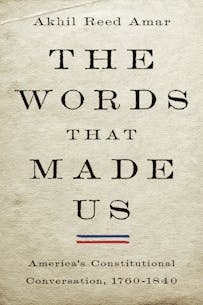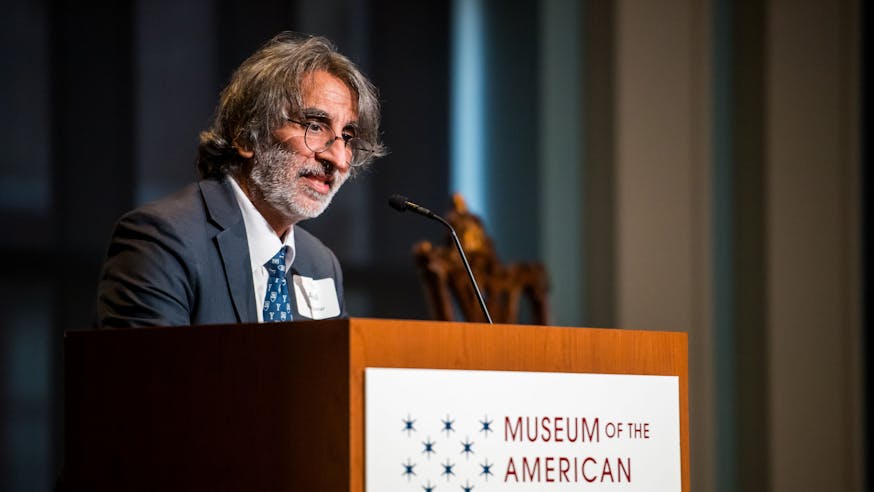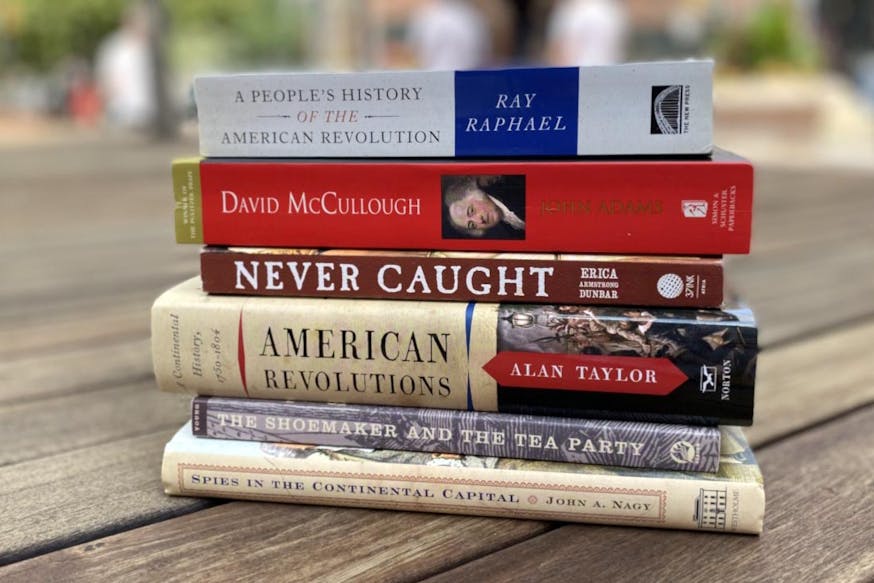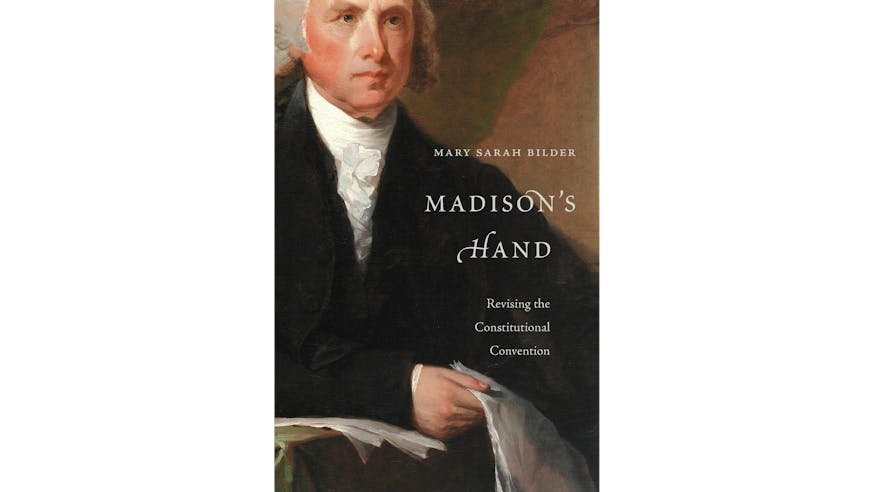Read the Revolution
The Words That Made Us
September 13, 2023
Purchase the book from Basic Books.
Beginning well before the outbreak of the Revolutionary War, British-Americans started to debate what bound them together – what constituted an American identity. In 1776, 13 colonies became new states with the aid of innovative, written state constitutions. And in 1789, those states ratified a pathbreaking document, the United States Constitution.
In The Words That Made Us: America’s Constitutional Conversation, 1760-1840, Yale professor of law and political science Akhil Reed Amar takes the long view of America’s Constitutional history. His volume begins with the ascension of King George III and concludes with the passing of the nation’s first Constitutional “conversationalists,” like James Madison, whose notes on the Constitutional Convention were published in 1840-41. The book is the first in what Amar anticipates will be three volumes tracing such conversations through 2020.
In this excerpt, learn more about the negotiations and discussions between New York’s Federalists and Anti-Federalists at the Poughkeepsie Convention in 1788 about whether to ratify the U.S. Constitution.
Excerpt
On July 2, 1788, exactly twelve years to the day after twelve states meeting in Philadelphia had agreed to declare themselves free and independent, word reached the Poughkeepsie Convention that Virginia had said yes to the Constitution. Back in 1766, New York’s Philadelphia delegation had not been authorized to say yes on July 2, and the colony had belatedly joined her twelve sisters on July 9. Now, history seemed to be repeating itself. New York’s sisters were leaving port, with or without her. Would she, once again, quickly board the good ship Union?
Word of New Hampshire’s July 21 ratification, which reached Poughkeepsie on June 24, had not seemed to faze the New York Anti-Federalists. Virginia’s ratification was different. Now, America’s three largest states—Virginia, Massachusetts, and Pennsylvania—were all aboard the ship. Now, there was no doubt that George Washington would lead the new United States of America. (Had Washington’s home state of Virginia said no, perhaps, some thought, he might choose home over union.)
On July 4, Philadelphians staged a joyous celebration and parade that attracted some twenty thousand merrymakers—the largest such gathering ever in post-independence America—and featured a grand constitutional oration by James Wilson, one of six men to have signed both the Declaration and the Constitution. Pennsylvania was of course already in the new union, and Philadelphia hoped to be America’s new capital—fittingly, thought many Philadelphians, given that the Constitution had originated in their hometown. Manhattanites had other ideas. On July 23, as the Poughkeepsie Convention neared its climax some eighty miles upstate, New York City Federalists staged their own massive celebration of the Constitution. Ten proud horses drew a twenty-seven-foot frigate named Hamilton (in honor of Alexander) through the cheering streets in a procession that stretched for a mile and a half.
Sign Up
Get biweekly Read the Revolution featured excerpts right to your inbox.
The stage was now set for a compromise. New York’s Anti-Federalists would need to say yes, but they hoped for some concession from Federalists to show the voters back home that they had not simply turned tail. Their initial offers tempted Hamilton and his fellow Federalists, who were not at all sure where the votes were in the room, but ultimately the Federalists stood firm.
First, the Anti-Federalists offered to ratify the Constitution “upon condition” that the new Congress take steps to initiative new amendments. The Federalists said no. The Constitution could be ratified with the hope and expectation of future amendments—“in full confidence” that the new Congress would make way for sensible constitutional revisions—but a formally conditional ratification was improper. The Federalists then beat back another Anti-Federalist motion: “that there should be reserved to the state of New York a right to withdraw herself from the Union after a certain number of years, unless” Congress acted on various amendment proposals.
At the risk of losing everything—and with all of America watching breathlessly—the Federalists thus insisted that New York say yes or no, cleanly. She could say “yes, but” as had Massachusetts and most post-Massachusetts states. But the “but” was not legally enforceable. Formally, ratifying conventions in Massachusetts and elsewhere were personally and publicly promising that they would support the various sensible amendments down the road. But Hamilton and his fellow Federalists insisted that, formally, ratification had to be unconditional. Any unilateral effort by a state to secede post-ratification would be unconstitutional, and any attempt to reserve such a right in the process of ratifying the Constitution was invalid.
In a July 20 letter to Hamilton, Confederation Congress member Madison (now back in New York City after his labors in Richmond) emphasized that “the Constitution required an adoption in toto, and for ever. It has been so adopted by the other States” (including Madison’s Virginia). On July 24, Hamilton read the letter aloud to the Poughkeepsie Convention and then invoked the Article VI Oath Clause obliging every state and federal public servant to follow the supreme law of the Constitution. That oath, Hamilton explained, “stands in the way” of any conditional ratification or purported reservation of a right of unilateral succession.
Printers and the public across the continent were watching the Poughkeepsie Convention’s climax with rapt attention. According to timely accounts published in more than a dozen newspapers circulating in virtually every state (including, notably, Virginia and both Carolinas), both Hamilton and his fellow delegate John Jay insisted that “a reservation of a right to withdraw . . . was inconsistent with the Constitution, and was no ratification.”
Thus, the only compromise the Federalists offered in late July was, strictly speaking, an informal one. New York could ratify on the Massachusetts yes-but model, and Anti-Federalist delegates could show their constituents all the amendment ideas that the convention had put into circulation and could further point out that many Federalist delegates had supported these ideas.
The decisive showdown took place on July 26. As that day dawned, no one knew for sure what the final vote county would be. Hamilton, Jay, Madison, and their allies had placed everything at risk—not just in New York, but, as a practical matter more generally—by insisting that no secession right whatsoever could be recognized and that no other formal condition of any sort could be attached. Had the Federalists, by taking this strict position, impaled themselves?
When the final vote tally was announced, the New York Federalists won by a single vote.
Akhil Reed Amar, The Words That Made Us: America’s Constitutional Conversation, 1760-1840 (New York: Basic Books, 2021).
Tags
Learn More

2023 Carl M. Buchholz Memorial Lecture with Akhil Reed Amar

Read the Revolution

